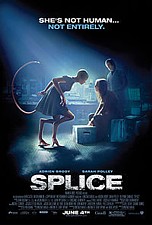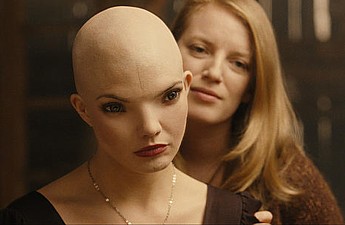
Director Vincenzo Natali gives birth to an instant classic
film from a queer perspective
Exclusive Web Review
| KATM media outlets |
| KATM featured weekly |
| Join Us! |
| KATM on RT |
| Vidcast Starring KATM |
| NOTE: THIS SITE ONLY LOADS CORRECTLY WITH EXPLORER AND MOZILLA BROWSERS - SORRY SAFARI USERS! |
| Buy the KATM Book |
Bravo:
Splice
6-11-10 KATM Exclusive Review
By Richard Knight, Jr.
Splice
6-11-10 KATM Exclusive Review
By Richard Knight, Jr.
| Splice begins with a nice, traditional creepy credit sequence (set to an ominous/beautiful main title music cue by the film’s composer Cyrille Aufort) the likes of which I haven’t seen (nor heard) since Alien/Resurrection. But where that ill-fated sequel failed to deliver on the anticipatory dread it so expertly set up, Splice is that rare sci-fi/horror movie that not only meets expectations but shoots over them and reaches that place that all fans of the genre dream of – the perfect synthesis of horror and the horrifically funny. This is the little indie that could. Co-writer/director Vincenzo Natali, collaborating on the script with Antoinette Terry Bryant and Doug Perry, and his crew have worked off and on their baby for a dozen years and it shows – it’s gorgeously shot and scored and the special effects (a mix of different techniques, new and old) are marvelously inventive. The work has paid off. Aside from artfully blending new and old thriller techniques, the movie is a gleaming, icy cube shot in dark blue, black and steel gray that visually warms up as the settings and colors change from the sterile laboratory to a deserted, womb-like barn (where emotions, to say the least, run high). Scene for scene, Splice has been my favorite film experience this year and it gave me more pleasure than a spate of bloated summer season pictures that have left me feeling whipped, numb, or perhaps worse, that indeterminate “it was okay” space somewhere between. I left Splice feeling exhilarated – horribly, deliriously happy with this monstrously ghoulish little movie. The tightly focused story follows a duo of gene splicing scientists Clive (Adrien Brody) and Elsa (Sarah Polley) who are first glimpsed as their latest example of creation is making its entrance into the world (we literally swirl up out of the liquid embryo “container” – setting for the aforementioned credits – as the creature is born). But the large corporation the couple work for see this animal hybrid and its mate (cunningly named Ginger and Fred) only for its pharmaceutical capacities and command Clive and Elsa to forgo their desire to move up the evolutionary chain and create a creature that will combine animal and human DNA. They want the financial rewards within their grasp now and announce that the experimental phase of the project is over. But Elsa, who clearly takes the lead in the laboratory and in the relationship with Clive isn’t about to give up so easily. In secret, she and Clive work at creating a strain resistant combination of animal and human DNA and miraculously, come up with the right formula. From the moment of her startling birth (a genuinely frightening sequence) Dren – as Elsa calls her (it’s “nerd” spelled backwards) – grows at an alarming rate. Clive is all for destroying Dren but Elsa convinces him, instead, to go ever further. Soon Dren, who sports ostrich-chicken-like legs and other animal parts, is being dressed in little baby doll dresses and being taught her letters and numbers by “mommy” Elsa. It is here that the blurring of identity really kicks in. The “child” fulfills a longing for both “parents” but only while she’s physically small and emotionally docile. All sorts of complications ensue as the duo try to hide their increasingly uncontrollable “offspring” as she outgrows her space physically and emotionally. Soon the basement containment area where they have moved Dren is too small and, shut up in a cardboard box at in the back of a van, Dren is transported to the childhood farm where Elsa grew up. Abandoned at the death of her mother and speaking of unimaginable childhood abuse horrors (think Sybil), it is in this creepy setting that the picture moves into its last and most outrageous act where Elsa realizes that Dren has become a competitor for Clive’s affections and things get really nutzo. Natali’s movie is an audacious yet traditional picture that liberally borrows from dozens of other memorable movies in the genre – good and bad – there are bits of Species, Alien, It’s Alive, Embryo, Freaks, Eraserhead, The Island of Dr. Moreau, Blade Runner, and more than a little bit of an homage to both directors David Cronenberg and James Whale (Natali’s lead characters Clive and Elsa are playfully named after Colin Clive and Elsa Lanchester – the stars, after Karloff, of the classic Bride of Frankenstein). Yet, like Clive and Elsa’s creation, Splice has an identity that is unique. The movie threatens but never descends into camp and that’s a credit not only to Natali’s intuitive editing (he seems to know just the right moment to cut away from his freakish creation) but also to the acting skills of Brody, Polley and the French actress Delphine Chanéac who plays Dren and gives a no-holds barred performance. This unholy trio gallop fearlessly into the realm of acting excess but rein it in over and over again just in the nick of time. In addition to drawing on the best of old school horror and sci-fi, Splice is a twisted homage to any number of parent-troubled offspring movies and most potently in the relationship of Dren and Elsa, rotten mother-defiant daughter flicks (think Mommy Dearest with a horror-sci-fi twist). Dren, whose growth spurts emulate that of a “normal” girl (and include rebellion and sexual desire) is a great template of a character – one can see her as the ultimate “other,” a militant lesbian, a transgender wonder, and a myriad of other gender variations. The allegories run rampant and the undertow of gender confusion is a persistent leitmotif throughout the picture. Both will most likely resonate with intuitive LGBT audience members who will quickly pick up on them. Natali’s twisted vision is a Pandora’s Box of a movie that will be as pleasurable the 50th time as the first and a sequel – set up nicely at the fade out – is hopefully in the offing. Unlike dozens of other film franchises, Dren is one potent sci-fi creature that one wants to see a lot more of. |





